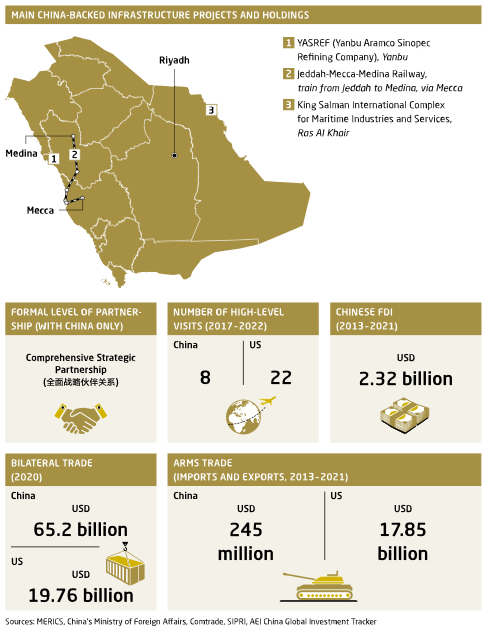At a glance
-
Chinese President Xi Jinping arrived in Saudi Arabia on Wednesday, December 7, to sign agreements and MOUs with the Kingdom and 30 Arab heads of states worth $29.26 billion, and to join two summits on December 8 and 9 — one with the Gulf Cooperation Council (GCC) countries and the other with leaders of Arab states.
-
The two countries plan to sign a strategic partnership agreement and a plan to harmonize the Kingdom’s Vision 2030 with China’s Belt and Road Initiative, and the Kingdom will also launch the Prince Mohammed bin Salman Award for Cultural Cooperation between the Kingdom of Saudi Arabia and the People’s Republic of China.
-
Xi Jinping’s visit comes at the invitation of Saudi Crown Prince Mohammed bin Salman, and underlines Beijing’s deepening ties with the kingdom at a time of increasing tension with the United States.
-
Western countries, especially the United States, see this as a growing partnership between the Middle East and China amid their own stressed relations with the region over OPEC+ cutting oil output.
-
This will be Xi’s first visit to Saudi Arabia since 2016.
Saudi Arabia will host the GCC-China Summit and the Arab-China Summit for Cooperation and Development — both firsts — in Riyadh on December 8 and 9 during President Xi Jinping’s visit to the Kingdom. Thirty Arab leaders and international organizations will attend the summits, representing a milestone for strategic partnership between Arab countries and China.
The Chinese delegation arrived in Saudi Arabia on December 7 and is expected to sign more than 20 agreements and MOUs with several GCC and Arab states. The deals are worth US$29.26 billion and span agriculture, investment, financing, energy, climate change, security and hi-tech industries.
Beyond the two summits, the visit will feature the launch of the Prince Mohammed bin Salman Award for Cultural Cooperation between the Kingdom of Saudi Arabia and the People’s Republic of China. The two countries will also sign a strategic partnership agreement and a plan to harmonize the Kingdom’s Vision 2030 with China’s “Belt and Road Initiative.”
This summit comes at a period of strained relations between Saudi Arabia and the US over the decision by OPEC+ to cut oil output by two million barrels per day. President Biden travelled to Saudi Arabia in July 2022 in hopes of patching relations with Crown Prince Mohammed bin Salman Al Saud and increasing oil production, but Saudi Arabia maintained its cuts on production volume, contributing to increased gas prices and inflation in the US. Following the October 2022 oil cut, some US officials have accused Saudi Arabia of siding with Russia and aiding President Vladimir Putin with his war on Ukraine. Both China and Saudi Arabia have refrained from endorsing sanctions on Russia, and Riyadh has repeatedly stressed that Moscow is a key energy-producing partner that must be consulted on OPEC+ decisions. Saudi Arabia has also resisted US pressure to choose sides concerning its ties with China, as Western countries face rising economic competition from China.
Meanwhile, China has increased its engagement efforts with countries in the Middle East as its economic interests expand in markets such as Africa, Latin America, Central Asia and the Middle East.
Xi Jinping attends the Arab-China Summit amid challenges back home
Following protests last week in several areas of China, some local Chinese authorities have started to ease COVID-19 restrictions in what appears to be a shift toward reopening after three years of strict zero-Covid measures.
On Tuesday, China’s National Health Commission announced 10 new updates to its Covid control measures that stop large-scale PCR testing, stop health checks for entry to most public venues and for most intercity travel, limit broad lockdowns, and allow for home quarantine for many cases, instead of being sent to centralized quarantine (Read more from EGA on the protests and easing Covid controls).
New era in China-Saudi Arabia relations
Over the past few years, GCC countries have been strengthening ties with China amid growing regional doubts about the commitment of their key regional security partner — the United States.
As its confidence in the umbrella of US protection wanes, Saudi Arabia is boosting cooperation with other world powers and aims to strengthen trade and cooperation on regional security with China.
China is already Saudi Arabia's largest trading partner. The Kingdom and China also have a significant and growing investment relationship. Saudi Arabia is the largest recipient of Chinese contracting and investment in the Middle East region — between 2013 and 2021, China’s FDI in Saudi Arabia totaled $2.32 billion — and unlike with the United States, China does not link its trade relationship to political values or human rights related issues. The main interest linking Saudi Arabia and China is energy. Saudi Arabia is China’s top global supplier of crude oil, and China is Saudi Arabia’s top crude oil customer, purchasing over a quarter of Saudi Arabia’s total crude oil exports in 2021 — an amount that is expected to grow. The International Energy Agency estimates that China will double its Middle East imports by 2035.
Anticipated reaction from the US
The Arab-China Summit pivots regional relationships more toward China, a development that will not be well-received in Washington. Xi’s visit will help to strengthen political and economic ties at a time when both countries are hedging their relationships with the US and the West. The visit will also have effects that reverberate beyond China and Saudi Arabia, and will be watched closely in Washington, DC, as policymakers attempt to understand the degree to which a strategic realignment in the Middle East is tilting the balance toward China.

